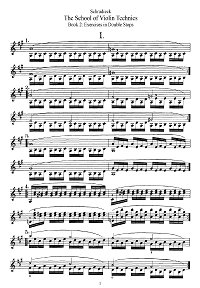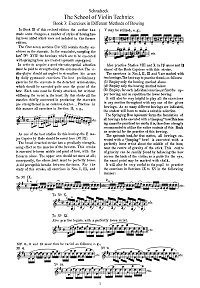Schradieck - The school of the violin technic
|
Schradieck - The school of the violin technic. You can download the PDF sheet music Schradieck - The school of the violin technic on this page.
In Book III of this revised edition the author has made some changes, a number of styles of bowing-having been added which were not included in the former edition.
The first seven sections (I to VII) contain chiefly exercises on the staccato. In .the remainder, excepting the last (N XVII) the bowings which are to be executed with springing bow are treated (spiccato arpeggios).
In order to acquire a good staccato, special attention must be paid to strengthening the arm-muscles. The violin-player should nut neglect to strengthen his arms by daily gymnastic exercises. The best preliminary exercise for the staccato is the detached wrist-stroke, which should be executed quite near the point of the bow. Each note must be firmly attacked, but without stiffening the wrist in the least. By this stroke all the muscles chiefly concerned in producing the staccato are strengthened in no common degree.
As one of the best studies for this bowing, the E major Caprice by Rode should be noted here (IX).
The broad detached stroke has a peculiarly strengthening effect on the muscles of the forearm. This stroke is executed between middle and point of bow, with the forearm alone. The upper arm should not move at all; consequently, the elbow-joint, must be perfectly loose. Avoid perceptible breaks between the tones.
Also practise Studies VIII and X (in F# minor and C# minor) of the Rode Caprices with this stroke.
To download PDF, click the "Download PDF" button below the appropriate sheet music image.
To view the first page of Schradieck - The school of the violin technic click the music sheet image.
|
| PDF format sheet music |
|
|
|
Book 2:
Double stops Exercises: 18 pages. 1704 K
|
Book 3:
Exercises in diff methods of bowing. 2935 K
|
 |
 |
|
|
| Download PDF (14.99
€) |
Download PDF (14.99
€) |
|
|
The exercises in Nos. I, II, III and V are marked with two bowings. The best way to practise them is as follows:
(1) Employ only the bowing marked above.
(2) Employ only the bowing marked below.
(3) Employ, for each individual exercise,at first the up - per bowing, and on repetition the lower bowing.
It will also be very helpful to play all the exercises in any section throughout with any one of the given bowings. As so many different bowings are indicated, the student will have to make a suitable selection.
The Springing Bow (spiccato) forms the foundation of all bowings to be executed with a "jumping" bow. This bowing cannot be practised too much; it is, therefore strongly recommended to utilize the entire contents of this Book as material for the practice of this bowing.
The spiccato (and, for that matter, all bowings executed with a "jumping" bow) is executed with a perfectly loose wrist about the middle of the bow, near the centre of gravity of the stick. This centre of gravity can be readily found by balancing the bow across the back of the violin; as a guide for the eye, the exact point may be marked with chalk.
|
|